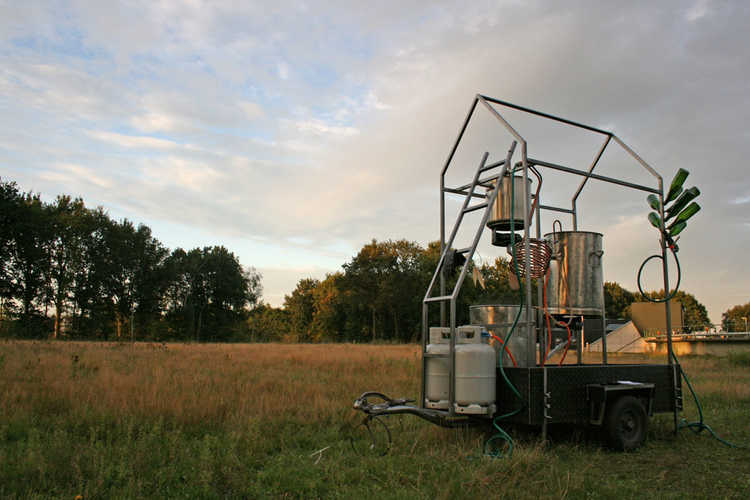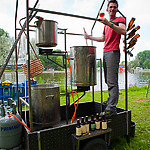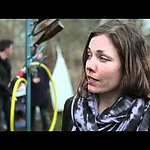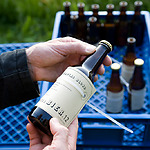Rainwater and wild plants from the surrounding area function as signature ingredients to the
unique brand of “landscape beer” (Landschapsbier) that is produced by the installation. By
using water from local ditches and heating, cooking, filtering, flavouring and fermenting it,
the Outside Brewery essentially makes a place or a landscape “drink-able” in the form of a beer. Since the start of the project in 2009, beer has been brewed in different locations around the Netherlands, producing a series of one-of-a-kind local brews. In the process, Waal developed some fine brewing skills of her own and even became a certified beer judge.
Co-designing an outside brewery
The Outside Brewery was originally developed in the framework of the cultural programme
“Eat-able Landscape” (Eetbaar Landschap) that was hosted by the city of Tilburg in 2009.
In and around the city of Tilburg alone, there are more than fifty amateur home brewers. Their makeshift breweries tend to be located in sheds and garages. They jointly produce an estimated 15,000 litres of beer annually. Waal mobilised these home brewers. They got to know each other and their surroundings in a special way. The joint design of the Outside Brewery followed, producing litres of Klavertje Bier from using the locally abundant red clover (Trifolium pratense) as its primary ingredient.
Ingredients: malt, water, and herbs
Water retrieved from a nearby ditch or pond is purified in a filtering tower. The filtering
construction consists of a used paper container, a fluid container, as well as individual water
bottles. Each of the containers holds a different filter, but all of them are made of natural
materials. The paper container holds a filter that is made of ceramics. The other filters use coal as well as sand in other to purify the water. After the filtering process is finished, Waal uses the water to brew beer by adding malt and— most importantly—a mix of locally harvested herbs that is used to add a distinct taste.
Life at the local brewery
Different landscapes generate different local ingredients, which in turn generate different
local beer recipes. “As designers, we are usually hosted by a given landscape without knowing very much about its specific qualities,” Waal says. She refers to the French concept of terroir, which can be loosely translated as “a sense of place,” and which represents the interaction between unique local characteristics that are expressed in agricultural products. At the core of the concept is the assumption that the land from which the product has grown imparts a unique quality that is specific to that growing site. The geography, geology and climate of a certain place all play their part in it. “In order to
truly understand the local, you need to collaborate with the locals,” she adds. “I always feel
the need to go local myself.” New local beers have surfaced, carrying meaningful names such as Rotterdam Snow Beer (Rotterdams Sneeuwbier), Sloterplas Blond Beer (Sloterplas Blond), Clover Beer (Klavertje Bier), and Rotsoord Beer (Rotsoord
Bier). During the Amsterdam Sloterplas Festival in 2010, the Outside Brewery brewed
Sloterplas Blond Beer, which is a clear beer made of water from Sloterplas Lake and has
a naturally low alcohol percentage of only 3%. The Outside Brewery is a mobile installation
capable of travelling. Additionally, designer Waal offers brewing workshops—she terms
them “beer education”—so as to make sure that people continue to have a sense of what they are actually drinking. And to safeguard this valuable Dutch cultural product from extinction.




Laat een reactie achter